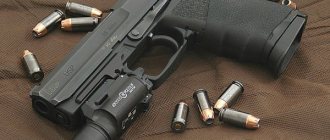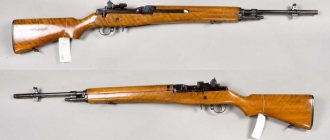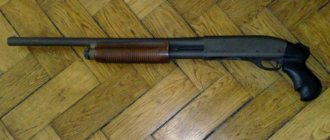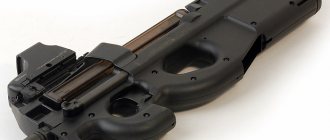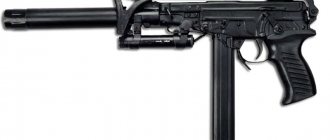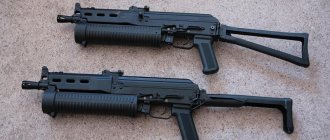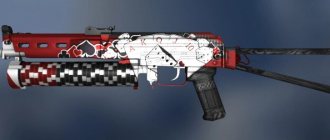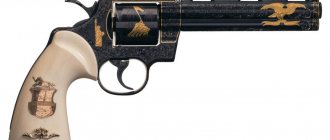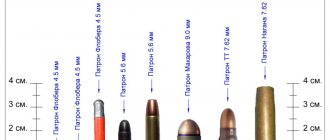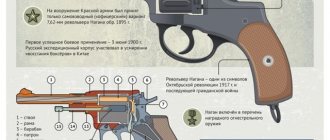The history of the appearance of the Nagant revolver
The Nagan system revolver is a product of the painstaking work of the Belgian gunsmiths brothers Leon and Emil Nagan, which subsequently underwent numerous modifications and can rightfully be called legendary. The initial model developed for the army was the six-shot officer model of 1878, which used 9.4x22 mm ammunition with a self-cocking trigger mechanism.
In 1883, the Nagan brothers introduced a revolver designed to arm junior ranks, called the 9-mm Nagan 1883 revolver. The difference from the “officer” model was in one detail that blocked the self-cocking system, which forced the hammer to be cocked manually before each shot. In 1886, the first modified version of the revolver was presented - changes affected the number of mainsprings, reducing them to one, and adaptation to the then widespread 7.5 mm ammunition with a pyroxylin charge.
Design features
Regardless of modification and year of manufacture, all revolvers have a number of characteristic features. These include:
- Monolithic frame of a revolver;
- Double-action trigger mechanism, allowing firing by self-cocking and pre-cocking;
- An original way to open the drum chamber: the door turns to the side;
- Barrel screwed into the pistol frame;
- A ramrod, which is recessed into the drum, and after firing acts as an ejector for spent cartridges.
In this design, the revolver drum is both a magazine and a chamber. The axle is hollow, held in place by a cleaning rod inserted into the front of the frame. Most models were equipped with a 7-round drum. The door is spring-loaded, and in the open position it provides access to the sockets for loading ammunition. When the door is in the firing position, it locks the drum, preventing it from turning counterclockwise, which prevents ammunition from falling out.
The design of the Nagan revolver
Trigger mechanism
This element was produced in two versions: double and single action. By the way, preference was given to the first version of the USM. The firing pin was attached to the trigger in a hinged manner, the spring was located in the pistol grip.
Firing accuracy
The revolver's sighting bar is configured for effective firing at a distance of 25 meters. From this distance, the aiming and hitting points coincide.
Impact force
The military commission of Tsarist Russia assessed this parameter by the revolver’s ability to pierce pine boards 1 inch (2.54 cm) thick. If we take this criterion as a basis, the revolver shows the following results:
- 3 boards break through with 100% probability;
- 4 boards - 70% penetration;
- 5 boards - 25%.
Here it is necessary to clarify that the given values are relevant for shooting from a distance of 25 meters, while the boards are located at an 8-centimeter distance from each other. One inch die can be easily penetrated from a distance of 140 meters.
Design of the 1895 Nagant revolver
The 1895 Nagant pistol was based on the 1892 model. But adapting the weapon to the requirements of the Russian army, it was equipped with a drum for seven rounds of 7.62 x 38 mm caliber, traditionally produced in two versions - “officer” with a self-cocking combat mechanism and “soldier”, requiring manual cocking of the hammer.
One of the design features of the weapon is the reloading method. To reload, it was not necessary to remove the drum; for this reason, it was on a spring-loaded axis, and for loading it was necessary to fold back the lid covering the chambers of the drum, which greatly slowed down the reloading process.
To remove the spent cartridges, the lid was also folded back, the cleaning rod was moved to the side, and by inserting it into the cavity of the cartridge case, extraction took place. But this innovation was also a plus - in non-standard situations, cartridges did not fall out of the drum, as, for example, happened in the Gasser revolver of 1870.
One of the key features of the weapon was the solution to the problem of breakthrough of powder gases, which reduced the power of the shot. To do this, they used a cartridge with a bullet recessed into a fairly long sleeve and changed the drum drive, which allowed it to move along its axis. Thus, during the firing process, the drum moved in the direction of the shot, and the sleeve protruding slightly beyond its limits entered the breech of the barrel. By expanding, the cartridge case blocked possible leaks of powder gases, and after the bullet left the barrel, the drum moved back along the axis, simultaneously bringing a new cartridge under the barrel. This principle was called “obturation,” created by the Nagan brothers’ closest competitor, Henri Piper, designer of the Bayard systems.
How the revolver works
The operating principle and design of the weapon does not differ significantly from the rest of its contemporaries, except for the obturation process. To fire a shot, the shooter pulls the trigger, uncocking the hammer. As the trigger moves, the drum moves along its axis and forward, driving the cartridge case into the breech of the barrel. The trigger hits the cartridge primer, igniting the powder mixture, and a shot occurs. The drum then moves back. The next shot repeats the process.
In the “soldier” version, it was necessary to manually cock the weapon before each shot.
Revolver “Nagant” interactive model
Revolver trigger
The trigger mechanism is a classic hammer type. The firing pin is attached to the trigger with a hinged mount. The combat plate is located in the handle. The sear and trigger are combined into one part. There is no safety cock; its role is played by a special part that blocks the interaction of the firing pin and the cartridge without pressing the trigger. When the trigger was pressed, the part was moved to the side, allowing the striker to puncture the capsule.
Cartridge for a revolver
The Nagan revolver cartridge 7.62 x 38 was specially designed for the 1895 model. The ammunition had a narrowed neck of the cartridge case, necessary for sealing in the barrel bore. It was thanks to this design that it became possible to create the BraMit modification.
Ballistic properties
The bullet demonstrated good accuracy for those times - at a distance of 25 meters, about half of the ammunition was placed in a circle with a diameter of 13 centimeters. If the shooter used a stop, then the diameter of the circle was reduced to 7 centimeters.
The penetrating ability of the bullet was also impressive - at a distance of 25 meters it pierced through three boards two and a half centimeters thick, standing at a distance of 8-10 centimeters from each other.
Encyclopedia of weapons
Revolver Nagan arr. 1895
Tactical and technical characteristics of Nagan arr. 1895: Caliber, mm - 7.62x38R (7.62 Nagant) Total length, mm - 235 Barrel length, mm - 110 Weight with drum without cartridges, g - 795 Weight with loaded drum, g - 880 Drum capacity - 7 Combat rate of fire - 7 shots at 15-20 s
The famous 7.62-mm Nagan revolver, adopted by the Russian army in 1895, was developed in Belgium and has a long history of its appearance. The Belgians Nagant brothers (Emile and Henri-Leon Nagant) began developing revolvers back in the 1880s, and by 1894 they had received patents for a revolver with powder gas obturation. In 1895, the revolver of the Nagant brothers system was adopted for service in Tsarist Russia, and - in two versions - for officers and police, a conventional revolver with a double-action trigger was provided (allowing shooting and self-cocking, that is, by pressing the trigger without first cocking the hammer .), and for the lower ranks the revolvers had a simplified single-action trigger (in which you need to cock the hammer manually before each shot).
The first deliveries of revolvers to Russia were from Belgium, but from about 1898 the production of revolvers mod. 1895 was established in Russia, in Tula at the Tula Arms Plant (TOZ). It is believed that a number of revolvers made in Russia were supplied to the Romanian army, but most likely this was an experimental batch intended for testing and testing.
Moreover, if the purchase price of a Belgian revolver was 30-32 rubles, then the Tula “Revolver” cost only 22 rubles 60 kopecks. The state order for the five-year period from 1895 to 1904 amounted to 180 thousand weapons.
The 1895 model revolver was distinguished by its comparative simplicity of design, manufacturability and low cost. The labor intensity of manufacturing one revolver was about 30 machine hours. At the same time, some assembly operations (installation of the mechanism axes into the frame) required fairly highly qualified personnel. In combat conditions, one of the main advantages was unpretentious operation and reliability: thus, a misfire did not in any way affect the possibility of firing the next shot and did not cause a delay. You can also note the high maintainability of the revolver.
The Model 1895 revolver was designed for a 7.62 mm caliber cartridge, which allowed Russian manufacturers to unify factory equipment for the production of both revolver and rifle barrels.
The stopping effect of the revolver bullet was small; some of its increase was achieved through the use of bullets with a cut off head. Combat strength from 35 steps (35 steps (25 m) on a package of dry pine boards, 2.54 cm (one inch) thick), located at a distance of 8 cm from each other, penetration is observed: 3 boards - 100% bullets, 4 boards - 70%, 5 boards - 25%.One board penetrates at a distance of up to 200 steps (140 m).
Revolver of the Nagan system arr. 1895 had a monolithic one-piece frame. On the left side of the frame there is a removable steel cover that follows the shape of the base of the handle and is designed for ease of inspection and maintenance of the weapon’s mechanisms. A round steel barrel with 4 right-hand rifling is screwed into the weapon frame. Under the barrel, on a movable coupling, there is a cartridge ejector rod, in the firing position located in the axis of the drum. On the outer surface of the drum there are oval valleys and small grooves for fixing the rotation of the drum. The trigger is C-shaped. The trigger guard is movable and can be lowered down if necessary. The wooden cheeks of the revolver handle are fastened together with a screw. The steel convex butt plate of the handle is oval, with a movably fastened ring for a safety cord.
Open-type sighting devices consist of a movable front sight with claws that slide into a groove in the base of the front sight on the barrel and a rear sight in the form of a long sighting groove on the upper plane of the frame, ending with a cut-out sight.
The trigger mechanism is of the hammer type with an open trigger, a long hammer is rigidly fixed to the trigger, the hammer is released. Loading and extraction are carried out one cartridge at a time through a hinged door on the right side of the frame; for extraction, a special extractor rod is used, partially hidden inside the hollow axis of the drum in the stowed position. The extractor is brought into working position by pulling it forward and turning it on a special rocking lever rotating around the barrel.
The loading and extraction scheme of the Nagant revolver was, of course, not ideal - revolvers of systems such as Smith and Wesson or Colt had drums that folded to the side, were simpler and had a higher practical rate of fire. However, revolvers arr. 1895 had an undeniable advantage over many other models and, above all, it was a method of obturation of powder gases. In other revolvers, when fired, part of the powder gases breaks into the gap between the breech end of the barrel and the front end of the drum, but in the Nagan this problem was successfully solved.
When cocking the hammer, a special lever pushed the drum slightly forward, while the tail part of the barrel entered the recess in the drum. In addition, the special 7.62 mm cartridge had an elongated, conical cartridge case with a protruding rim. The bullet was completely buried inside. The muzzle of the cartridge case was narrowed, and when the drum moved forward, it entered the breech of the barrel, providing additional obturation. This design complicated the design of the revolver, but provided real advantages over traditional systems. First of all, this is the survivability of the weapon and the accuracy of the battle, for which they were so valued by professional shooters.
The presence of self-cocking ensures that the weapon is always ready to fire and quickly opens fire. The revolver has good shooting accuracy due to its easy-to-hold layout and low recoil force.
Good flexibility ensures ease of shooting offhand and an aiming range of up to 50 m. The trigger pull of the revolver is about 1.5 kg when the hammer is cocked, allowing accurate shooting without disrupting the aiming of the weapon. When firing by self-cocking, the force of cocking and releasing the hammer is approximately 3.5 kg, which ensures safety in handling the weapon and allows for fairly accurate shooting at a distance of up to 20 m.
The disadvantages of the Nagan include low muzzle energy (about 200 J), which negatively affects the effectiveness of the impact on living targets - the lethal and stopping effect of the bullet is small for a weapon of this caliber. The “soldier” model is not suitable enough for self-defense. Its lack of self-cocking and the high position of the trigger spoke, which makes it difficult to cock it with the hand holding the weapon, practically eliminate the instant use of the weapon.
The main disadvantage of the revolver design is the difficulty of reloading it. In fact, it is a single-use weapon, since reloading in close combat is almost impossible, which negates the advantage in cylinder capacity compared to other revolvers. The small powder charge makes the cartridge sensitive to temperature changes. Thus, in severe frost, the initial speed of the bullet drops to 220 m/s, which makes shooting at even a weakly protected enemy ineffective.
One of the first baptisms of fire of the Russian version of the “Nagant” occurred on June 3, 1900, during the pacification of the so-called “Boxer Rebellion” in China by Russian troops.
Reductions in War Department appropriations since 1903 led to a sharp decline in revolver production, and the outbreak of the Russo-Japanese War forced the government to use emergency loans for the purchase of weapons. In 1905, the Tula plant was ordered to produce 64,830 units of the 1895 model revolver, but only 62,917 revolvers were produced. After the war, funding for the army rearmament program was once again reduced, and an interdepartmental commission created in 1908 allowed the production of revolvers according to orders directly from military units.
So, in 1912 - 1913. For a separate border guard corps, they produced a number of revolvers with barrels extended to 300 mm and wooden butts. The carbine was intended for mounted shooters and allowed for targeted shooting at a distance of up to 100 meters. However, the large size (total length is almost 700 mm), the low destructive power of a light bullet and the slowness of reloading prompted the abandonment of the elongated revolver. At the same time, they developed a version of a revolver with a 200 mm long barrel and a removable wooden butt for arming lower ranks in the technical troops (machine gunners, signalmen, telegraph operators, sappers), who were previously issued both rifles and revolvers. But this model was also considered unacceptable.
The tsarist government began preparing for a big war too late: the “Great Program to Strengthen the Army” was announced only on July 7, 1914, three weeks before the start of the First World War. At this time, the armies of developed countries begin to replace revolvers with self-loading pistols, the best examples of which are superior to revolvers in combat characteristics (especially in rate of fire, reloading speed and dimensions). In Russia, another rearmament was considered inappropriate.
By July 20, 1914, according to the report card, the troops had 424,434 Nagant revolvers of all modifications (out of 436,210 required by the state), that is, the army was provided with revolvers by 97.3%, but already in the first battles the losses of weapons were significant. Measures were taken to reconstruct the arms industry, and 474,800 revolvers were produced between 1914 and 1917.
The production of revolvers did not stop either during the revolutionary years or during the Civil War. From 1918 to 1920 alone, 175,115 thousand Nagant revolvers were produced. By the mid-20s. The Soviet state was able to begin revising the equipment of the Red Army (Workers' and Peasants' Red Army) and supplying it with new types of weapons. Taking into account the experience of the First World War and the Civil War, it was decided to modernize well-proven revolvers simultaneously with the creation of self-loading pistols.
Only the self-cocking (“officer”) version of the revolver with a double-action trigger was adopted into service with the Red Army, while the technological documentation was transferred to the metric measurement system in 1918. During the Civil War, the Tula Arms Plant continued to produce revolvers - 175,115 units were produced between 1918 and 1920. (52,863 units in 1918, 79,060 units in 1919 and 43,192 units in 1920).
After the end of the civil war, the issue of rearmament of the Red Army was repeatedly raised. Officially, Nagans were declared obsolete in Russia in 1930, with the adoption of the model pistol. 1930, but production of Nagans continued until 1950.
In 1927, the Tula plant mastered a modification with a shortened barrel (up to 85 mm) and handle - a “commander’s” revolver, intended for operatives of the OGPU and NKVD, where the specifics of the service required the concealed carrying of weapons. It was produced in small quantities until 1932.
In 1929, the Mitin brothers developed a silencer (PBS) for a revolver - the so-called “Bramit device” (BRAMIT - MItin Brothers), which made it possible to successfully use the revolver during reconnaissance and sabotage operations of the Red Army during the war. The device was a cylinder with a diameter of 32 mm and a length of 140 mm, the inner part of which is divided into two chambers, each of which ends with a seal with a cylindrical gasket made of soft rubber 15 mm thick. A cut-off device is placed in the first chamber; in the walls of the chambers there are two holes with a diameter of 1 mm for bleeding off powder gases. When fired, the bullet pierces both seals in turn and exits the device; the powder gases, expanding in the first chamber, lose pressure and are slowly released through the side hole to the outside. Part of the powder gases, which broke through the first seal along with the bullet, expands in the second chamber. As a result, the sound of the shot is significantly dampened.
In June-July 1930, the design and production technology of the revolver underwent a slight modification: the sight slot became semicircular instead of triangular, the front sight was supposed to be changed to rectangular, but then a more complex semicircular-truncated shape was introduced.
The cost of one Nagan revolver (with a set of spare parts) in 1939 was 85 rubles.
Until the beginning of World War II, the production of revolvers and pistols at the Tula plant was maintained at approximately the same level; from 1932 to 1941, more than 700,000 revolvers were produced. The advantages of pistols were quite obvious to the leadership of the Red Army, but for a number of reasons the TT pistol and revolvers were produced in parallel. One of the reasons was the opinion that the pistol must be suitable for firing through the embrasures of a tank. The TT pistol was clearly not suitable for this, and new models of pistols that had a barrel that was not covered by a casing turned out to be worse than the TT. In 1941, the Tula Arms Plant was evacuated to Udmurtia, to the city of Izhevsk, where the production of revolvers continued, and in 1942 a partial re-evacuation was carried out from Izhevsk to Tula.
More than 370,000 revolvers were produced between 1942 and 1945. During wartime, the percentage of defects in production increased, due to the lack of qualified personnel. The finishing quality of military-issue revolvers was lower than in peacetime. The combat use of revolvers revealed the obsolescence of its design and insufficient combat qualities; the most noticeable loss in comparison with self-loading pistols was the low practical rate of fire (that is, a large loss of time for reloading).
After the end of the Great Patriotic War, the revolver was removed from service with the Soviet army and its production was discontinued. However, Nagan system revolvers were in service with the police until the mid-1950s, and in the paramilitary security and collection systems for much longer.
In total, more than 2 million Nagan system revolvers were produced in Russia.
Modifications
- Nagan officer arr. 1895 - Officer version, double-action trigger (self-cocking), issue 1898
- Nagan soldier model 1895 - Soldier version. Single action trigger.
- Nagan arr. 1895/1930 - Soviet modernization of the officer model 1895, issue 1930.
- Nagan arr. 1895/1930 - shortened version with a shortened barrel, produced in 1930.
- Nagan 1895/1930 - training training revolver, produced in 1930.
See also Nagant Mle.1895 Russian.
‹ TOZ (Tula) Up System. Cow arr. 1924 ›
Operation and combat use
The 1895 Nagant revolver went through a long battle path, ending it in the mid-2000s: the suppression of the Yihetuan uprising, the Russo-Japanese War, two world wars, the October Revolution and the Civil War - this is not a complete list of armed conflicts where the revolver was used in combat. In the mid-nineties, they remained in service only with geological expeditions, but even from there they were withdrawn as an obsolete weapon.
Use in Russia and USSR
The Nagan revolver became the standard weapon of officers of the army of the Russian Empire in 1895. But due to the constant reduction of the military budget, it was possible to equip the army with the necessary amount of weapons only in the second half of 1917.
How the revolver appeared in the Russian army in 1895
At the end of the 19th century, the question of rearmament of soldiers and officers of the Russian army was raised. The officers' personal small arms were Smith & Wesson III 1880 revolvers. The heaviness and inconvenient dimensions, unsatisfactory technical characteristics only hindered its use.
To select the optimal model, the Ministry of War decided to hold a competition for the development of personal weapons. There were only two competitors - the brothers Nagan and Henri Pieper with the Bayard 1889 model. For unknown reasons, the results of the first competition were canceled.
The second competition took place some time later, as a result of which the Nagan brothers won, providing a weapon that fully met the performance characteristics of the commission’s requirements. According to the rules of the competition, the winner had to renounce the right of monopoly production, ensure the transfer of drawings and set up the production of weapons in Russia, and also had obligations to supply the first batch of weapons.
The opinion of the officers who participated in the tests was also important. It was thanks to the opinion of these officers that the decision was made to divide the weapon into an officer's revolver and a soldier's revolver, the difference between which lay in the design of the trigger. The unanimous opinion was that junior ranks of the army should not be trusted with a self-cocking weapon model due to the low level of shooting training, and the model with a double-action trigger was slightly inferior in accuracy due to the heavy trigger, and, accordingly, a sharp jerk when firing.
1900-1917
From the moment it was put into service until the 1917 revolution, the revolver managed to establish itself as an unpretentious and reliable weapon, having passed through several major military conflicts with honor. Also, in 1915, the modernization was finally rejected, which actually turned the revolver into a carbine with a barrel length of 300 mm.
1917-1939
Having become a model of weapon reliability, Nagan continued to serve in the Red Army, but only in the self-cocking version. The only modernization during this period was carried out in 1930, slightly changing the shape of the sighting devices. Around the same years, the tradition took root of considering all revolvers to be the “Nagan” system, which is fundamentally incorrect.
1939-1945
For a number of reasons, weapon production was not stopped after the adoption of the TT semi-automatic pistol. One of them was the possibility of firing from personal weapons through the embrasures of a tank, for which TTs were not suitable, and new weapon models did not pass factory tests.
The process of evacuation of the Tula arms factory to Izhevsk greatly affected the quality of weapons. Most of the qualified specialists were called up to the front in the ranks of the active army. The process of outflow showed itself to be especially strong in the case of Nagan revolvers produced in 1942, when a fairly large percentage of defects was revealed during the production of weapons.
However, in 1945, the production of revolvers was discontinued due to obsolescence. At the same time, the Nagant was finally removed from the army's arsenal. But he remained in service in the ranks of law enforcement agencies and the justice system.
7.62 mm Nagant revolver mod. 1895 (Russia/USSR)
Belgian-made Nagant mle.1895 revolver
At the end of the 19th century, the Russian Empire began massive rearmament of its army. The “Three-line rifle of the 1891 model” was chosen as the main model of small arms. The standard revolver was a model of the 4.2-line (10.67 mm) Smith-Wesson III revolver of the 1880 model, which was obsolete by that time. The Commission for the development of small-caliber guns, headed by Lieutenant General N. G. Chagin, was involved in the search for promising models. The main requirements for the new army revolver were as follows:
- Great stopping power of the bullet. Since cavalry was one of the main types of troops, a shot at an effective range (up to 50 steps) should stop a horse.
- The “fighting force” should be capable of penetrating four to five inch pine boards.
- Light weight (0.82-0.92 kg).
- The caliber, number, direction, profile of the barrel rifling, etc. must coincide with those of the three-line rifle of the 1891 model, then in the manufacture of revolvers it will be possible to use defective rifle barrels.
- The revolver should not be equipped with a self-cocking firing device, because it “harmfully affects accuracy.”
- The initial velocity of the bullet must be at least 300 m/s.
- The revolver must have good accuracy of fire.
- The design should be simple and technologically advanced.
- The revolver must be reliable, insensitive to dirt and poor operating conditions, and easy to maintain.
- The extraction of cartridges should not be simultaneous, but one after the other.
- Sights must be designed so that the bullet's flight path intersects the aiming line at a distance of 35 steps.
- Drum capacity is at least 7 rounds.
- Cartridge with flanged brass case, jacketed bullet and smokeless powder.
- The rejection of self-cocking firing and simultaneous extraction of spent cartridges was caused by the opinion that, firstly, they would complicate the design (which would negatively affect the reliability and cost of the revolver), and secondly, they would lead to “excessive consumption of ammunition.”
The announced competition and potential gigantic order aroused enormous interest among domestic and foreign arms manufacturers. Several modifications of the existing Smith and Wesson revolver were introduced, including revolvers and automatic pistols. The main struggle took place between the Belgian gunsmiths Henri Pieper with the M1889 Bayard revolver model and Leon Nagan with the M1892.
Leon Nagant had to remake the revolver for the Russian 7.62 mm caliber and, as in 1883, eliminate the possibility of self-cocking shooting, worsening the characteristics of the weapon in accordance with the requirements of the competition. Two options were presented - 6- and 7-round revolvers. Pieper's revolver was rejected due to its large mass and unreliable design. Leon Nagant's victory in the competition was probably largely due to the fact that he already had long-established connections in the Russian military department.
For a patent for a revolver, Nagan asked for 75,000 rubles, which he was ultimately denied and a repeat competition was scheduled with new, clarified conditions. In addition to the characteristics, they stipulated a bonus: 20,000 rubles for the design of the revolver and 5,000 for the design of the cartridge; in addition, the winner “gave his invention into the full ownership of the Russian government, which received the right to manufacture it both in his country and abroad, without any additional payment to the inventor.” Pieper submitted to the competition newly redesigned revolvers with original automatics, which the commission considered “ingenious, but not practical.” S.I. Mosin's six-barreled revolver was also rejected.
The improvements in the design of the Nagant revolver were less significant, and after comparative tests with the 4.2-line Smith-Wesson revolver, the design was approved. Based on the results of military tests, the officers participating in them expressed an insistent desire to obtain a double-action revolver with the ability to self-cocking. Returning to the self-cocking version of the revolver, the commission did not consider it completely satisfactory, so it was decided to adopt two types of revolvers for service with the Russian army: self-cocking for officers and non-self-cocking for non-commissioned officers and privates.
After making a number of minor changes, the design was approved in the spring of 1895. On May 13, 1895, by decree of Nicholas II, the “soldier” and “officer” models of the Nagan revolver were adopted by the Russian army, but according to the military department, revolvers were officially adopted into service in June 1896, by order of the Minister of War No. 186.
The contract provided for the delivery of 20,000 Model 1895 revolvers over the next three years. The Belgian side was also contractually obligated to provide assistance in setting up the production of revolvers at the Imperial Tula Arms Factory. The design of the Russian-made revolver underwent a slight modernization: the back of the handle was made solid (and not split, as in the Belgian version), and the shape of the front sight was simplified. Production technology has also been improved. The order for five years (from 1899 to 1904) amounted to 180,000 units.
For 20 thousand revolvers produced, Nagan received more than 600 thousand rubles. gold. One Belgian Nagan cost 30–32 rubles. For comparison, the price of the French M1892 revolver was 60 francs (15 rubles). After the start of production of the Nagan in Russia, it cost the treasury 26 rubles. (which corresponded to 17 rubles 33 kopecks before the reform of 1897). Subsequently, the leadership of the military department set the task of reducing the cost of the revolver to 20 rubles. In other words, “Naganov’s cheapness” is another legend. “Nagants” of Belgian production appear in Russia and for commercial sale, and at a price of only 25 rubles. (this corresponds to 16.67 rubles before the reform of 1897). We must not forget that this amount also includes the store’s trade margin. In other words, the Belgian “sold” his products to the Russian Imperial Army at essentially double the price.
Tactical and technical characteristics of the Nagan system revolver
| Curb weight, kg | 0,88 |
| Total length of weapon, cm | 22 |
| Barrel length, cm | 11,4 |
| Number of barrel rifling | 4 |
| Cartridge | 7.62 x 38 mm |
| Sighting range, m | 25 |
| Drum capacity | 7 rounds |
| Initial bullet speed, m/s | 260 |
| Aim | open, unregulated. |
| Combat rate of fire, rounds/min. | 7 shots in 15-20 seconds |
For shooting from a revolver with the BraMit device installed, it was recommended to use a pointed Nagant cartridge of 7.62 x 38 mm caliber.
Main modifications of Nagant
Nagant 1910 - a modified model, had a drum that tilted to the right to increase reload speed.
Combat
- The Soldier's Nagan is a revolver with a single-type trigger. Out of production in 1918.
- The Commander Nagan is a revolver with a self-cocking trigger; for concealed carry, the barrel was shortened and the handle was reduced. Mainly used by NKVD officers.
- version for sabotage operations, modified by the Mitin brothers. The process of pressing the cartridge case into the breech of the barrel has been improved; it is possible to mount a silent combat device designed by the Mitins. Also for this modification, cartridges with a pointed bullet were developed.
Civil
The emasculated Nagan (abbreviated as SHP), as well as its MMGs, converted from combat copies, but deprived of the ability to fire a shot, are very popular among collectors and weapon lovers. Also, due to its legend, the empty Nagan revolver is often found in films, TV series, etc.
Sports
Based on the Nagan, the following variants of sporting weapons were developed:
- A revolver designed by Smirny in 1926 chambered for a 5.6 mm rimfire cartridge.
- The 1953 Nagant revolver had a weighted barrel and an adjustable sight. Single action trigger
- MTs-4 designed by Paramonov.
- TOZ-36 is a sports revolver designed by Khaidurov.
- TOZ-49 - modernization of Khaidurov’s revolver chambered for 7.62 x 26 mm.
- TOZ-96 is a model chambered for .32 S&W Long Wandcutter.
Sporting and hunting weapons
- KR-22 “Falcon” is a conversion model with a 500 mm long barrel, designed for hunting small animals. Caliber .22LR.
- The Gnome is a sports training pistol chambered for the 4 mm Flaubert cartridge.
Civilian self-defense weapon
Gas and traumatic versions of weapons are produced on the basis of decommissioned combat revolvers:
- Traumatic revolver R-1 “Naganych” chambered for 9 mm RA cartridge;
- Traumatic revolver Nagan VPO-502 and service RS for caliber 10 x 23T;
- Skat-1R;
- Brigade commander;
- Nagan RF;
- RNR UOS;
- Skat-1Rk is sometimes called shortened Nagan;
Also in Ukraine, the production of G-Nagan has been established - a classic version, converted into a gas revolver for self-defense.
Tuning
The first revolver, model 1895, consisted of 41 parts, while remaining simple and easy to use. This design feature provided almost limitless scope for gunsmiths and simply home craftsmen to modernize these weapons.
In particular, the emphasis was on giving the revolver a more modern look and improving combat qualities. For these purposes, weapons were equipped with handles made of textile or valuable wood, optical sights were installed, and homemade butts were installed. The only thing that the home-grown “Kulibins” never touched was the trigger mechanism. This suggests that the USM, created more than 100 years ago, remains relevant in the modern world and does not need improvement.

